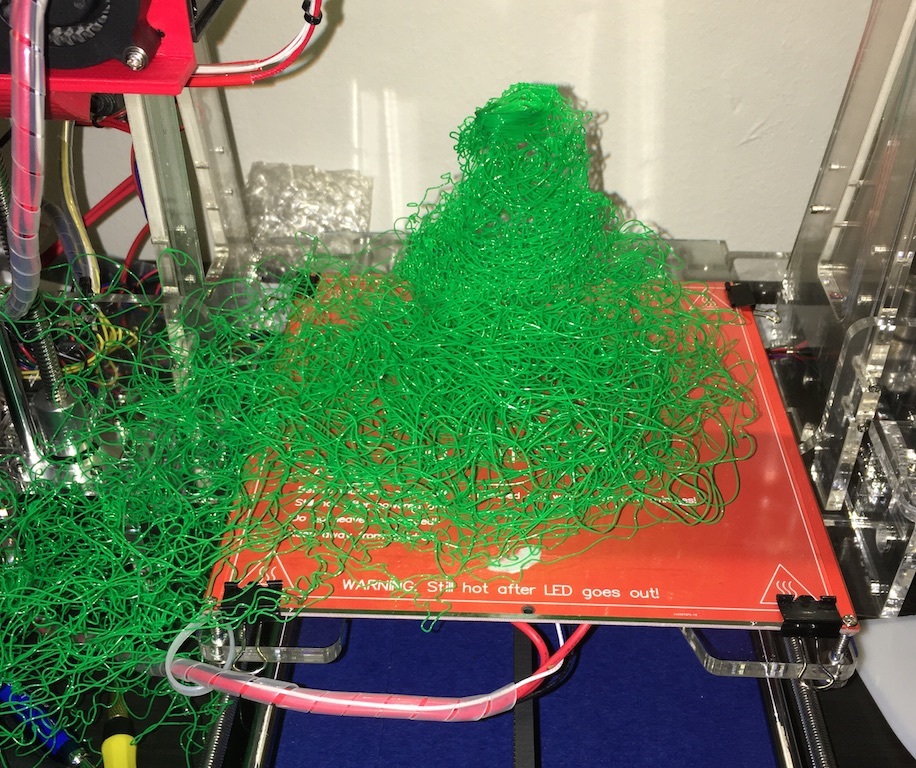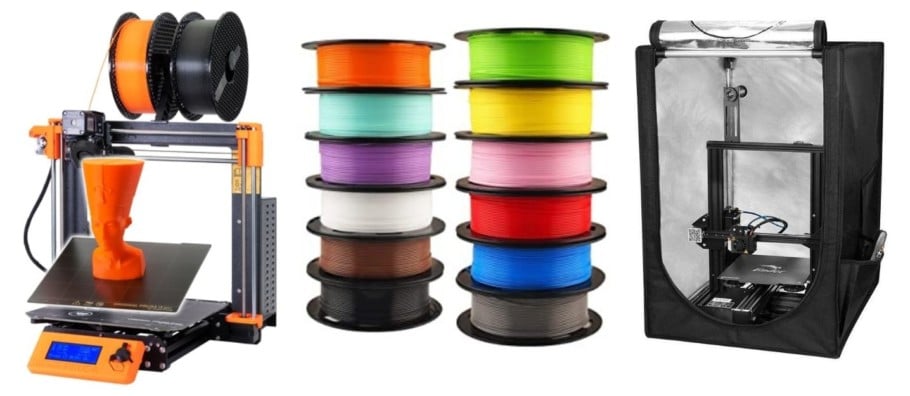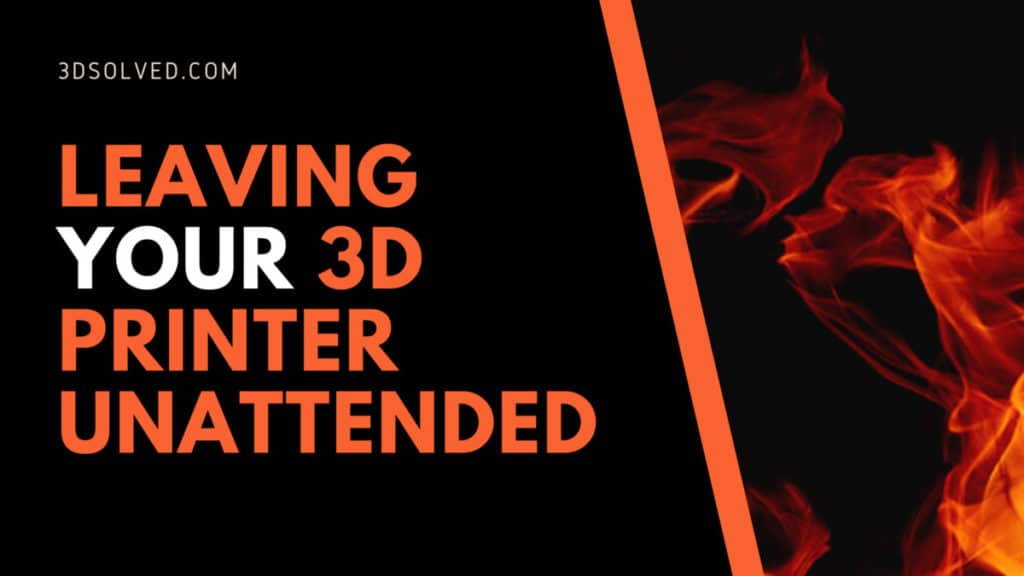We have all been there; we start a new printing project that is going to take forever to finish but we have the patience of a five year old!
We might be tempted to calculate the completion date assuming that our machine will work 24 hours a day. So, before we start our batch, we should ask ourselves (or google): Is it safe to leave our 3D printer unattended?
You should not leave your 3D printer unattended, since it poses various major hazards. There have been reported cases of printers catching on fire due to poor wiring or heated bed failures. Prints can also detach from to surface while being printed, leaving the remainder of the job extruding filament and causing a mess.
We will look at various suggestions going around on the internet and discard most of them, as they are not actually safe. First, let us get our blood pumping by reviewing what can go wrong if we leave our malicious and ill-intended printer unattended.
Things that might go wrong
First, let us go through the most typical scenarios where things go south in 3D printing. In order to keep things fun, I will alternate the hazards with a few 3D printer bloopers (*1) that, although not probable, should also be avoided. It is always good to laugh a little bit while learning (*2).
(*1): They are substantially less funny if you are the owner of said printer.
(*2): Is it really? According to whom?
Fire Hazards
I think there is no need to justify why you should be somewhat interested in avoiding this from happening, but here it goes: some things tend not to work as well after they catch on fire. This applies not only to your 3D printer but also to your furniture and the house that surrounds it.
Most fires start because of electrical issues, such as wires, components, or terminals overheating. Although the overheated object may not be flammable, it can be in direct contact with another object that is.
Although the market has pushed manufacturers to improve the overall quality and safety of their products, they still are prone to failure. This is especially true for low budget, generic printers.
If you bought a kit and assembled it yourself, avoid leaving the printer unattended for the first couple weeks.
We should also consider that the failure could originate on the software side. I always remember this fact when updating my printer’s firmware.
Most firmware updates are thoroughly tested before being shipped to everyone, but you can always be the first user to find a bug and report an issue. Perhaps you also tweaked or upgraded your printer in a way that generates incompatibilities with the new firmware version.
I think I am just going in circles now… just do not leave your printer unattended right after an update. Never trust that sneaky machine!

Print detaching from the build surface
If you own a 3D printer, this must already have happened to you. It is not uncommon that one of the parts that are being printed gets detached from the printing surface in mid-print.
What usually happens is that the user detects that the extruder is printing nonsense and stops the entire job. Otherwise, you come back half an hour later to see a 3D Jackson Pollok. In both cases, the worst aspect of this scenario is the sheer frustration that we face, but we can clean the surface and hope that our next trial will succeed.
Things can go terribly bad if you go to work and leave your printer unattended for 8 hours straight. Averaging 15grams of filament per hour, you could have up to 120grs laying around.
I am not only talking about wasting filament but more importantly about the possibility of said filament ruining your machine. A visual aid might convince you!

Safety measures
Because I am not a pyromaniac, I have plenty of incentive to avoid my printer from catching on fire. There is just no upside! That is why I did plenty of research on this topic. I have read hundreds of forum threads, and hundreds (tens) of articles on the topic.
I will first go through those recommendations that, albeit done by knowledgeable and good-intentioned folks, are not sufficient in my humble opinion.
I want to emphasize that all of the below recommendations are clear safety improvements if you choose to implement them. I just do not want to give you the false feeling that you can safely leave your 3D printer unattended and runaway with a CNC.
Know all about your 3D printer wiring:
I partially agree with this recommendation. Who in its right mind would be against knowing more about how a 3D printer works?
You might be able to detect a possible hazard before it occurs.
Knowing about your wiring and regularly checking if everything looks fine will go a long way in preventing most problems. Having said that, I do not think that it will guarantee that your printer is always going to work properly on its next job.
Have a live camera pointing at your printer
You can regularly check how your print is doing while you are not at home. In addition to setting up your camera, implement some remote command in order to react when things seem suboptimal. Otherwise, you are just live-streaming a catastrophe to your coworkers.
Let us not discard this as an option just yet. There is value in knowing that everything is working properly and not finding out if something did go wrong when you get home.
If 3D printers would have existed in 1935, we would all know the famous thought experiment as “Schrodinger’s 3D Printer”. I guess it would go as follows:
“If you leave your machine unattended, the print is simultaneously a success and a failure.”
Have a smoke detector:
This goes without saying, but you should have a smoke detector regardless of your 3D printer.
If you do not already have one and did not budget it for this month’s expenses, sell your 3D-printer and buy one. No excuses, I know you have one!
Have a fire extinguisher in the same room
This is actually quite good advice. As soon as I read it on Reddit, I ordered an extra one just to place it nearby. I just think it is “not sufficient” because this article deals with unattended printers and a fire extinguisher is rather useless when no human is around.
If you are buying a fire extinguisher for this purpose, please keep in mind that we are dealing with electrical equipment, so it is necessary to use a Type C extinguisher.
Only use the heated bed when necessary
The logic behind this reasoning is actually quite sound. Heated beds are one of the major causes of fire events in 3D printing. If you only use it when needed, you are reducing the risk of fire without a doubt.
It is worth mentioning that it is not always recommended to turn off the heated bed. I would not even dare to try printing something in ABS without a heated bed or an enclosure.
Nonetheless, turning your heated bed off has its disadvantages. While you are clearly reducing the fire hazard probability, you are also exposing your print to detaching from the surface.
Overall, having weighed its pros (lower fire hazard) and cons (hire detachment probability); it might be a net positive to turn off the heated bed. Just remember both pictures I showed above.
Get a metal enclosure
Adding a metal enclosure to your 3D enclosure is definitely my favorite and recommended safety measure (YouTube video). It not only servers as an inflammable barrier between the printer and its surroundings, but also helps to cut off the oxygen and extinguish the flame.
If you have a relatively popular model, there sure is an enclosure that you can just buy and start using. Otherwise, you can improvise one rather easily. I mean, roughly speaking, it is just a metal box.
If going that route is not an option, Creality came out with their own affordable version of a non-flammable enclosure which also works well, just not as well as creating a fully metal one (but it’s also much more affordable)!
Conclusion
I hope that by now I convinced you that causing a fire in your house tends to have a negative effect on your belongings.
Additionally, you can mitigate most risks by adding a metal enclosure or buying a non-flammable one, having a working smoke detector and fire extinguisher, and regularly checking the wiring of your machine.
You can also set up a live camera feed and periodically check its status while your printer works unattended.
Check out our recommended products section

We created a recommended products section that will allow you to remove the guesswork and reduce the time spent researching what printer, filament, or upgrades to get, since we know that this can be a very daunting task and which generally leads to a lot of confusion.
We have selected just a handful of 3D printers that we consider to be good for beginners as well as intermediates, and even experts, making the decision easier, and the filaments, as well as the upgrades listed, were all tested by us and carefully selected, so you know that whichever one you choose will work as intended.
Error processing API data.
